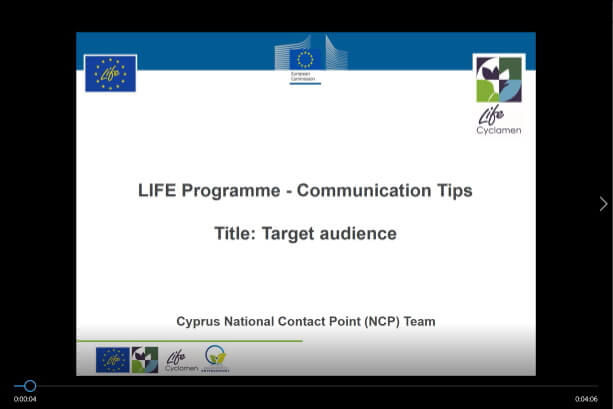
This is a video on communication tips related to the LIFE Programme. Part of a series of videos aiming at helping you with your communication actions.
In this video, we will share our 1st Communication tip regarding your target audience.
To start with, let’s see the definition of the target audience. Your target audience includes the individuals, groups and communities that have influence and decision making power over the topic of your project. They are the ones you are trying to attract, therefore, they are the people you want to communicate with.
By clearly identifying your target audience, it becomes easier to capture their attention because their needs, goals and interests are central to your communication. This process can take time, research and fine-tuning, but it provides valuable insight into the needs and motivations of an audience that can potentially influence what you are trying to achieve.
When designing your communication strategy you need to clearly define your target audience. In order to achieve this you should consider the following:
- Who do you want to talk to? Do you want to talk to the general public? Or to a group of experts? Or maybe to both?
- Segment your target audience for better results of your communication. If for example your target is the general public it might be best to segment your audience into two groups – adults and children! That way your communication can be more targeted based on each segment’s needs and interests.
- Connect with existing networks for easier and more effective reach to the right group of people.
- And remember! Different projects have different target audiences.
Now let’s see an example. The project comes from Hungary and it’s called LIFE-FOODWASTEPREV (Food waste prevention in the food chain to support the implementation of the 7th Environment Action Programme – LIFE15 GIE/HU/001048). It aimed to change attitudes to food waste in Hungary, leading to a reduction in the quantity of such waste generated by Hungarian households.
LIFE-FOODWASTEPREV had different communication actions for each target audience with the aim of creating:
- Awareness and behaviour change in primary school children
- Awareness and behaviour change in adults
Let’s see some examples of these communication actions! The 1st Example aimed in creating awareness around food waste and behaviour change in primary school children. This infographic was specifically designed for primary school children, providing them with clear information about what food waste is and why it is harmful to the planet. This infographic would have reached the children’s parents, thus increasing the action’s reach.
Building on this first action the project organized a summer camp. 5 000 schoolchildren participated in a food waste prevention competition. The four most outstanding classes in the competition were invited to participate in this summer camp as a reward. The main aim of the camp was to educate children further on food waste prevention and achieve the desired behaviour change.
The 2nd Example aimed in creating awareness around food waste and behavior change in adults. This informational flyer contained practical and easy to understand suggestions on how to reduce food waste. Following the awareness that this project had previously achieved, recipients of this flyer can now follow these suggestions and change their harmful habits related to food waste.
This is our first Communication Tip for LIFE projects! Thank you so much for watching. This video was prepared by the Cypriot NCP Team through the LIFE Cyclamen project. With the financial contribution of the LIFE Programme – EU’s funding instrument for the environment and climate action.
Don’t forget to like, subscribe and hit the notification bell to be instantly informed about our next videos that will be published soon.
Stay tuned for more of our Communication Tips the LIFE Programme!


